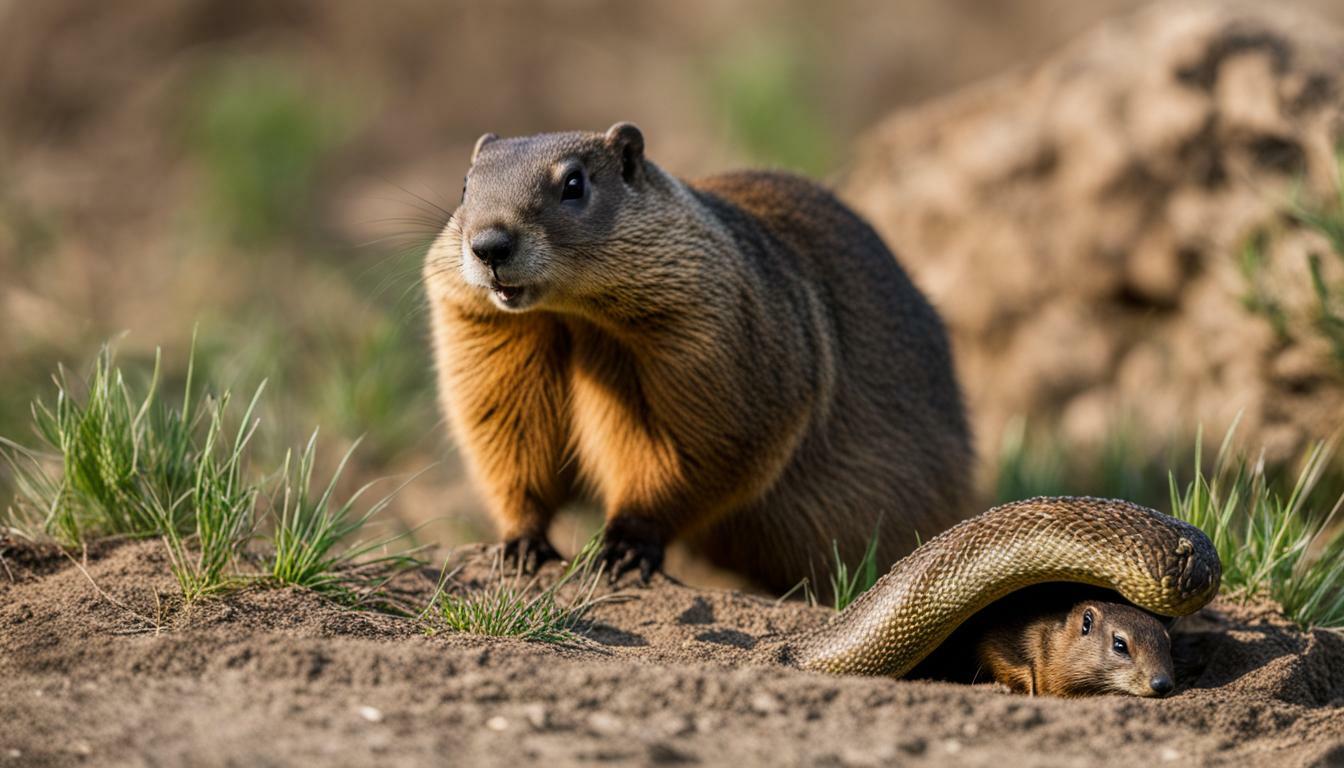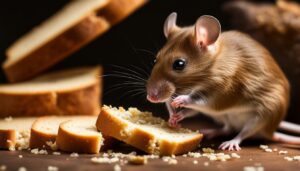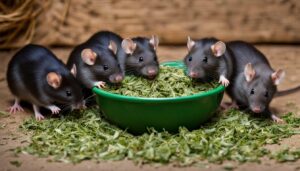Many people wonder whether groundhogs have any impact on snake populations or if they can help keep snakes away from their property. Groundhogs are primarily herbivores, but they may prey upon smaller animals like baby birds and insects when given the chance. While groundhogs may not specifically seek out snakes as prey, they can attack and kill them if they feel threatened or if the snake poses a danger to their young. Groundhogs do not have a direct role in keeping snakes away, but their burrowing behavior can indirectly affect snake habitats by disrupting or destroying nesting or hibernation sites. Ultimately, the presence or absence of snakes in an area is influenced by various factors such as food availability, shelter, and temperature, and groundhogs do not serve as a consistent deterrent for snakes.
Key Takeaways:
- Groundhogs are primarily herbivores but may prey upon smaller animals if given the opportunity.
- Groundhogs can attack and kill snakes if they feel threatened or if the snake poses a danger to their young.
- Groundhogs’ burrowing behavior can indirectly affect snake habitats by disrupting or destroying nesting or hibernation sites.
- Snakes’ presence or absence is influenced by various factors such as food availability, shelter, and temperature.
- Groundhogs do not serve as a consistent deterrent for snakes.
Understanding Groundhog Behavior
Groundhogs are primarily herbivores, but they may exhibit certain behaviors when encountering snakes in their environment. It is important to understand their natural behavior and habitats to better comprehend their interactions with snakes.
Groundhogs, also known as woodchucks, are known for their burrowing behavior. They construct complex underground burrows that serve as their homes and provide protection from predators. These burrows can extend several feet deep and have multiple chambers for different purposes, such as nesting, hibernation, and storing food.
Groundhog Habitats and Snakes
Groundhogs prefer open areas with abundant vegetation, such as fields, meadows, and the edges of forests. They are often found in close proximity to water sources, which provide hydration and a food supply. These habitats also attract various other wildlife, including snakes.
While groundhogs do not specifically seek out snakes as prey, they may perceive them as a threat. When a groundhog encounters a snake, it may exhibit defensive behavior, such as emitting warning sounds, standing on its hind legs, or even attacking the snake if it poses a danger to the groundhog or its young.
| Groundhog Behavior Towards Snakes | Groundhog Habitats and Snakes |
|---|---|
| Defensive behavior when threatened by a snake | Prefer open areas with abundant vegetation |
| Warning sounds and standing on hind legs | Often found near water sources |
| May attack snakes if they pose a danger | Attracts various wildlife, including snakes |
However, it is important to note that groundhogs do not serve as a consistent deterrent for snakes. The presence or absence of snakes in an area is influenced by multiple factors, including food availability, shelter options, and temperature. Therefore, relying solely on groundhogs to keep snakes away may not be effective.
Understanding groundhog behavior and their interaction with snakes is valuable for creating a snake-free environment. Implementing a combination of natural snake deterrents, such as removing potential hiding spots and sealing entry points, can help prevent snakes from entering your property. Additionally, maintaining a balanced ecosystem that supports biodiversity is crucial for the overall health of the environment.
Groundhog Burrows and Snake Deterrence
Groundhog burrows can have unintended consequences for snakes, potentially discouraging them from establishing their homes in the vicinity. As groundhogs dig and expand their intricate tunnel systems, they inadvertently disrupt or even destroy snake nesting and hibernation sites. The disturbance caused by the construction of burrows can make the area less favorable for snakes, as they rely on secure and undisturbed locations to lay their eggs or enter into hibernation.
The intricate network of tunnels created by groundhogs can also pose physical obstacles for snakes. The complex maze of underground chambers and passages can make it difficult for snakes to navigate and move freely, deterring them from settling in such areas.
However, it is important to note that while groundhog burrows can have some impact on limiting snake populations in specific locations, they are not a foolproof snake deterrent. Factors such as food availability, suitable shelter, and temperature also play a significant role in determining the presence or absence of snakes in an area. It is crucial to consider multiple factors when developing strategies for effective snake prevention.
| Pros of Groundhog Burrows as Snake Deterrent | Cons of Groundhog Burrows as Snake Deterrent |
|---|---|
|
|
Conclusion
While groundhog burrows can indirectly deter snakes by disrupting their habitats, it is important to recognize that groundhogs alone are not a reliable method for snake prevention. Creating a snake-free environment requires considering various factors such as eliminating food sources, sealing entry points, and implementing landscape modifications. Additionally, exploring natural snake deterrents and maintaining a balanced ecosystem can contribute to effective snake control. By understanding the relationship between groundhogs and snakes and implementing comprehensive prevention strategies, you can help reduce the presence of snakes in your surroundings.
Groundhogs as Natural Predators for Snakes
Although groundhogs are primarily herbivores, they have been known to attack and kill snakes if they pose a threat. Groundhogs have powerful jaws and sharp teeth that they can use to defend themselves or their young against predators. While groundhogs do not actively seek out snakes as prey, they will not hesitate to defend themselves if they feel threatened by a snake.
Groundhogs are generally peaceful animals, and their interactions with snakes are typically limited to self-defense. If a groundhog encounters a snake that is deemed dangerous or poses a risk to their burrow or young, they may exhibit aggressive behavior. This can include chasing, biting, or even killing the snake to protect their territory.
It’s important to note, however, that groundhogs do not serve as a consistent deterrent for snakes. While they may act as occasional predators, the presence or absence of snakes in an area is influenced by various factors such as food availability, shelter, and temperature. Groundhogs primarily contribute to the ecosystem as herbivores, and their burrowing behavior can indirectly affect snake populations by disrupting or destroying nesting or hibernation sites.
| Groundhogs as Natural Predators for Snakes | Summary |
|---|---|
| Groundhogs have been known to attack and kill snakes if they pose a threat. | Groundhogs are primarily herbivores but can exhibit aggressive behavior when necessary. |
| Groundhogs do not actively seek out snakes as prey, but will defend themselves if needed. | Groundhogs contribute to the ecosystem as herbivores, and their burrowing behavior can indirectly affect snake populations. |
In summary, groundhogs can act as natural predators for snakes when they feel threatened or perceive them as a danger to their territory. However, their role as snake deterrents is not consistent, and other factors such as habitat, food availability, and temperature play a significant role in snake populations. Groundhogs primarily serve as herbivores and contribute to the ecosystem through their burrowing behavior. While they may occasionally prey upon snakes, relying solely on groundhogs for snake prevention may not be effective.
Factors Influencing Snake Populations
The presence or absence of snakes in an area is influenced by several factors, including food availability, shelter, and temperature, not solely groundhog presence. Understanding these factors can help create a more comprehensive approach to snake prevention.
Food Availability
Snakes primarily feed on a diet of small mammals, birds, insects, and amphibians. The abundance of these food sources in a particular area can directly impact snake populations. For example, an area with a high population of rodents may attract snakes due to the availability of prey. Alternatively, an area with limited food sources may discourage snakes from establishing a habitat.
Shelter
Snakes require suitable habitats for breeding, nesting, and hibernation. Factors such as vegetation density, rock crevices, fallen logs, and human-made structures can provide the necessary shelter for snakes. Groundhogs, with their burrowing behavior, can indirectly impact snake populations by disrupting or destroying potential nesting or hibernation sites. However, other factors such as the presence of natural or artificial shelters also play a significant role in determining snake habitat suitability.
Temperature
Snakes are ectothermic, meaning they rely on external sources of heat to regulate their body temperature. Different snake species have specific temperature requirements for optimal activity and survival. Factors such as climate, sunlight exposure, and thermal gradients in an area can influence snake populations. Groundhogs, being mammals, do not directly affect snake populations in terms of temperature regulation.
| Factors Influencing Snake Populations | Summary |
|---|---|
| Food Availability | Availability of prey can attract or discourage snakes. |
| Shelter | Availability of suitable habitats impacts snake populations. |
| Temperature | Climate and thermal conditions influence snake activity and survival. |
The Role of Groundhogs in Snake Control
While groundhogs can have some impact on snake populations, they are not a comprehensive solution for snake control. As primarily herbivorous creatures, groundhogs do not actively seek out snakes as prey. However, if they feel threatened or if a snake poses a danger to their young, groundhogs have been known to attack and kill snakes.
The behavior of groundhogs, particularly their burrowing habits, can indirectly affect snake populations by disrupting or destroying snake nesting and hibernation sites. Groundhogs create extensive burrow systems, which can interfere with the shelter and nesting areas that snakes rely on. This can lead to a decrease in snake populations within groundhog habitats.
However, it is important to note that the presence or absence of snakes in an area is influenced by various factors. These include food availability, shelter options, and temperature conditions. Groundhogs alone are not a consistent deterrent for snakes, as other environmental factors play significant roles in snake populations.
In summary, while groundhogs may have some impact on snake populations, they are not a reliable or comprehensive solution for snake control. It is essential to consider alternative methods and strategies for effective snake prevention and control, taking into account various natural snake deterrents and creating a snake-free environment that addresses all relevant factors.
Groundhogs and Snake Infestations
Groundhogs may provide some level of assistance in reducing snake infestations, particularly if their burrowing activities disrupt the snakes’ preferred habitats. As primarily herbivores, groundhogs do not actively seek out snakes as prey. However, when feeling threatened or perceiving snakes as a danger to their young, groundhogs can attack and kill them.
While groundhogs are not a direct deterrent for snakes, their burrowing behavior can indirectly impact snake populations. Groundhogs create extensive tunnels and burrows, which can disrupt or even destroy snake nesting and hibernation sites. By compromising these habitats, groundhogs make it less desirable and conducive for snakes to inhabit an area.
It is important to note that the presence or absence of snakes in a particular area is influenced by various factors beyond groundhog behavior. Food availability, shelter options, and prevailing temperatures all play a role in snakes’ habitat preferences. Therefore, while groundhogs may play a limited role in reducing snake infestations, they do not serve as a guaranteed solution.
| Pros | Cons |
|---|---|
| Groundhogs can attack and kill snakes if they feel threatened. | Groundhogs primarily prey on plant food and are not actively hunting snakes. |
| Groundhog burrows can disrupt or destroy snake nesting and hibernation sites. | Snakes’ presence in an area is influenced by various factors such as food availability, shelter, and temperature. |
| Groundhogs may indirectly contribute to reducing snake populations by making their preferred habitats less desirable. | Groundhogs alone are not a guaranteed solution for snake infestations. |
In summary, groundhogs may provide some level of assistance in reducing snake infestations by disrupting snake habitats through their burrowing activities. However, it is crucial to consider other factors that influence snake populations. Creating a snake-free environment requires a holistic approach that goes beyond relying solely on groundhogs. By considering alternative natural snake deterrents and implementing practical prevention measures, you can effectively mitigate snake infestations and maintain a balanced ecosystem.
The Truth About Groundhogs and Snakes
While groundhogs can have interactions with snakes, their overall impact on snake populations should not be overestimated. Groundhogs are primarily herbivores and their diet consists mainly of plant food. However, they may prey upon smaller animals like baby birds and insects when given the chance. Snakes, on the other hand, are more likely to be predators of groundhogs than the other way around.
Groundhogs do not actively seek out snakes as prey, but if they feel threatened or perceive a snake as a danger to their young, they may attack and kill it. This behavior, however, is not a consistent deterrent for snakes. Snakes have various factors influencing their presence in an area, such as food availability, shelter, and temperature.
Although groundhogs’ burrowing behavior can indirectly affect snake habitats by disrupting or destroying nesting or hibernation sites, this alone does not significantly impact snake populations. Other factors like natural predators, competition for resources, and environmental conditions play a more significant role in determining snake populations. Therefore, relying solely on groundhogs for snake prevention would not be effective.
| Groundhogs and Snakes | Key Points |
|---|---|
| Groundhogs | – Primarily herbivores – May prey on smaller animals like baby birds and insects – Do not actively seek out snakes |
| Snakes | – Can be predators of groundhogs – Presence influenced by various factors – Groundhogs alone are not a consistent deterrent |
| Impact on Snake Populations | – Groundhogs’ burrowing behavior can indirectly affect snake habitats – Other factors like natural predators and environmental conditions have a greater influence – Relying solely on groundhogs for snake prevention is not effective |
While groundhogs may have interactions with snakes, it is important to understand that their role in snake control is limited. To create a snake-free environment, it is recommended to consider other natural snake deterrents as well. These may include removing potential hiding places, sealing gaps or cracks in buildings, and keeping the surrounding area clean and free of debris. By maintaining a balanced ecosystem where natural interactions between groundhogs and snakes contribute to overall biodiversity, we can promote a healthy environment for all species.
Exploring Natural Snake Deterrents
For those seeking ways to deter snakes, various natural methods can be more reliable than depending solely on groundhogs. While groundhogs may have limited influence on snake populations, incorporating additional measures can enhance snake prevention efforts. Here are some effective natural snake deterrents to consider:
1. Habitat Modification:
Make your surroundings less appealing to snakes by modifying their habitat. Keep your yard clean and tidy, removing piles of debris, rocks, and brush that can serve as hiding spots. Trim vegetation, especially near the home, to eliminate potential snake resting places. By reducing snake-friendly environments, you can discourage their presence.
2. Natural Repellents:
Explore natural repellents that can act as deterrents to snakes. Some commonly used substances include sulfur, cinnamon oil, and clove oil. Sprinkling these around your property or in specific areas can create an unfavorable environment for snakes. However, it’s important to note that repellents are not foolproof and may not be effective against all snake species.
3. Physical Barriers:
Installing physical barriers is another effective method to prevent snakes from entering certain areas. This can include erecting snake-proof fencing around your property or specific zones, such as garden beds or play areas. The fence should be made of a material that snakes are unable to climb or slither through, such as metal or fine mesh. Regularly inspect and repair any gaps or openings in existing fencing.
Remember, no single method can guarantee complete snake deterrence. It’s important to combine different strategies and assess your specific situation to develop an effective snake prevention plan. By understanding the behavior and preferences of snakes, as well as implementing natural deterrents, you can minimize the likelihood of encountering these creatures on your property.
| Method | Effectiveness | Considerations |
|---|---|---|
| Habitat Modification | High | Regular maintenance required |
| Natural Repellents | Variable | Effectiveness varies by species |
| Physical Barriers | High | Regular inspection and maintenance necessary |
Creating a Snake-Free Environment
To prevent snakes from becoming a nuisance, it is important to implement multiple measures that go beyond relying solely on groundhogs. While groundhogs may have some influence on snake populations, there are additional steps you can take to ensure a snake-free environment.
1. Seal Entry Points
Snakes can enter your property through small gaps and cracks in walls, windows, doors, and foundations. Conduct a thorough inspection of your property and seal any potential entry points. Use caulk or weatherstripping to seal gaps around windows and doors, and consider mesh screens for vents and openings.
2. Remove Attractants
Snakes are attracted to areas with abundant food sources, such as rodents and insects. Keep your property clean and free of debris to discourage these pests from taking up residence. Regularly trim vegetation and remove clutter, as these can provide hiding spots for both snakes and their prey.
Additionally, consider removing bird feeders if they are attracting small animals that snakes may prey upon.
3. Modify the Landscape
Make your property less attractive to snakes by modifying the landscape. Keep grass and vegetation well-maintained, as shorter grass reduces hiding spots for snakes. Clear away piles of leaves, wood, and rocks, as these can provide shelter for snakes.
If you have a garden, consider using raised beds or containers to deter snakes from nesting or hiding among your plants. Install a snake-proof fence around areas where you want to keep snakes out.
4. Educate Yourself
Understanding snake behavior and species prevalent in your area can help you take appropriate preventive measures. Research the types of snakes that are common in your region and learn about their habits. This knowledge will enable you to identify potential risks and take necessary precautions.
5. Seek Professional Help
If you have a persistent snake problem or are unsure how to handle the situation, it’s best to consult with a professional pest control service or wildlife expert. They can conduct an assessment of your property, provide advice tailored to your specific situation, and implement effective snake prevention strategies.
| Snake Prevention Tips | Pros | Cons |
|---|---|---|
| Seal entry points | – Helps keep snakes out – Also prevents other pests – Can be done by homeowners |
– Requires time and effort – May not be 100% effective |
| Remove attractants | – Discourages snake prey – Promotes overall property cleanliness – Relatively easy to implement |
– Does not guarantee snake prevention – May not be feasible for all property types |
| Modify the landscape | – Creates less snake-friendly environment – Reduces potential hiding spots – Can enhance property aesthetics |
– May require ongoing maintenance – Limited effectiveness against determined snakes |
| Educate yourself | – Enables proactive prevention – Helps identify potential risks – Promotes better understanding of snakes |
– Does not physically deter snakes – Requires time and effort |
| Seek professional help | – Expert assessment and advice – Tailored solutions for your situation – Ensures safe and effective pest control |
– May involve additional cost – Dependent on availability of local professionals |
Maintaining a Balanced Ecosystem
Understanding and respecting the natural interactions between groundhogs and snakes is crucial for maintaining a healthy and balanced ecosystem. While groundhogs may not actively seek out snakes as prey, they can occasionally attack and kill them if they feel threatened or perceive them as a danger to their young. However, it is important to note that groundhogs do not serve as a consistent deterrent for snakes.
Groundhogs primarily have an herbivorous diet, feeding mainly on plant food. Their burrowing behavior, though not directly intended to keep snakes away, can indirectly affect snake populations by disrupting or destroying nesting and hibernation sites. This disruption can impact the overall snake population in an area, but it does not completely eliminate the presence of snakes.
Factors such as food availability, shelter, and temperature play a crucial role in determining snake populations. Therefore, relying solely on groundhogs as a means of snake prevention may not be effective. It is essential to consider other natural snake deterrents and implement strategies to create a snake-free environment.
| Factors Influencing Snake Populations | Groundhog as a Natural Predators for Snakes |
|---|---|
|
|
While groundhogs can contribute to maintaining a balanced ecosystem by indirectly affecting snake populations, other natural snake deterrents should also be considered. Implementing strategies to create a snake-free environment, such as removing potential hiding spots and ensuring proper yard maintenance, can be more effective in preventing snakes from entering your property. By taking a holistic approach to snake prevention, you can maintain a healthy ecosystem while minimizing the risk of snake encounters.
Conclusion
While groundhogs may have some impact on snakes, creating a snake-free environment requires a comprehensive approach that takes into account multiple factors. Groundhogs are primarily herbivores and do not actively seek out snakes as prey. However, when feeling threatened or when their young are in danger, groundhogs can attack and kill snakes.
Groundhogs’ burrowing behavior can indirectly affect snake populations by disrupting or destroying their nesting and hibernation sites. This can make certain areas less favorable for snakes. However, it’s important to note that the presence or absence of snakes in a specific location is influenced by various factors, including food availability, shelter, and temperature.
Therefore, relying solely on groundhogs as a snake deterrent is not a foolproof solution. To effectively create a snake-free environment, it is crucial to consider other natural snake deterrents and implement comprehensive prevention measures. These measures may include removing potential snake hiding spots, sealing entry points to buildings, and maintaining a well-maintained landscape that discourages snake habitation.
By understanding the complex relationship between groundhogs and snakes, we can better appreciate the role of both species in maintaining a balanced ecosystem. While groundhogs may offer some benefits in certain situations, it is important to approach snake prevention with a holistic mindset, considering the broader factors that influence snake populations and taking appropriate measures to create a safe environment for all inhabitants.
FAQ
Do groundhogs keep snakes away?
Groundhogs do not have a direct role in keeping snakes away. The presence or absence of snakes in an area is influenced by various factors such as food availability, shelter, and temperature.
Are groundhogs herbivores?
Yes, groundhogs are primarily herbivores and their diet consists mainly of plant food. However, they may prey upon smaller animals like baby birds and insects when given the chance.
Can groundhogs attack snakes?
Groundhogs can attack and kill snakes if they feel threatened or if the snake poses a danger to their young.
Do groundhogs directly deter snakes?
Groundhogs do not serve as a consistent deterrent for snakes. However, their burrowing behavior can indirectly affect snake habitats by disrupting or destroying nesting or hibernation sites.
What role do groundhogs play in snake control?
Groundhogs have a limited role in snake control and should not be relied upon as the sole method of snake prevention.
Can groundhogs help mitigate snake infestations?
While groundhogs may offer benefits in certain situations, they alone are not sufficient for mitigating snake infestations.
Are there other natural snake deterrents?
Yes, there are alternative natural snake deterrents that can be more effective than relying solely on groundhogs.
How can I create a snake-free environment?
Creating a snake-free environment involves considering factors beyond groundhog presence, such as removing potential food and shelter sources for snakes.
Why is maintaining a balanced ecosystem important?
Maintaining a balanced ecosystem where the natural interactions between groundhogs and snakes contribute to overall biodiversity is crucial for the health of the ecosystem.




